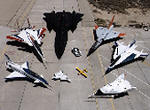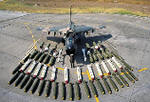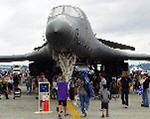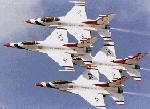
|
Description
| Manufacturer: | Boeing | |
| Base model: | PW-9 | |
| Designation: | PW-9 | |
| Equivalent to: | FB-1 | |
| Designation System: | U.S. Air Force | |
| Designation Period: | 1919-1924 | |
| Basic role: | Pursuit, Watercooled | |
| Crew: | Pilot | |
Specifications
| Length: | 23' 5" | 7.1 m | |
| Height: | 8' 2" | 2.4 m | |
| Wingspan: | 32' | 9.7 m | |
| Wingarea: | 260.0 sq ft | 24.1 sq m | |
| Empty Weight: | 1,936 lb | 878 kg | |
| Gross Weight: | 3,120 lb | 1,414 kg | |
Propulsion
| No. of Engines: | 1 | ||
| Powerplant: | Curtiss D-12 | ||
| Horsepower (each): | 435 | ||
Performance
| Range: | 390 miles | 628 km | |
| Cruise Speed: | 142 mph | 228 km/h | 123 kt |
| Max Speed: | 160 mph | 257 km/h | 138 kt |
| Climb: | 1,630 ft/min | 496 m/min | |
| Ceiling: | 18,925 ft | 5,768 m | |
Known serial numbers
Recent comments by our visitors
| Robert Dougherty Ashfield, PA | A PIONEERING FIGHTER
After gaining experience from the licensed production of the Thomas-Morse MB-3A, Boeing embarked on the design of its first fighter, and the resulting Model 15 prototype made its maiden flight in June 1923 as a sturdy unequal-span biplane with the D-12 inline engine, fixed tailskid landing gear, and a fabric-covered combination of steel-tube fuselage and wooden flying surfaces. The US Army evaluated it as the XPW-9 and then ordered two additional prototypes, the second of them with the original through-axil main landing gear replaced by divided main landing gear units of the type specified for the 30 PW-9 fighters ordered in 1925. SIMPLE BUT EFFECTIVE IMPROVMENTS There followed an order for 25 PW-9As with the improved D-12C engine and duplicated flying wires, but the last was delivered with improvements as the sole PW-9B. There should have followed 15 PW-9B production fighters with the D-12D engine, but these and another 25 aircraft were delivered as PW-9Cs with modified fittings for the flying and landing wires. The last of these were later modified with an aerodynamically balanced rudder and a number of other improvements, and this paved the way for 16 PW-9D fighters. The revised rudder was retrofitted to most surviving aircraft of the PW-9 series. Boeing planned a number of other improvements for the projected PW-9E, but the army cancelled this type. 04/14/2000 @ 16:01 [ref: 78] |
Recent photos uploaded by our visitors





